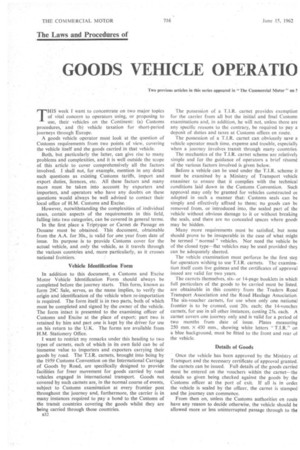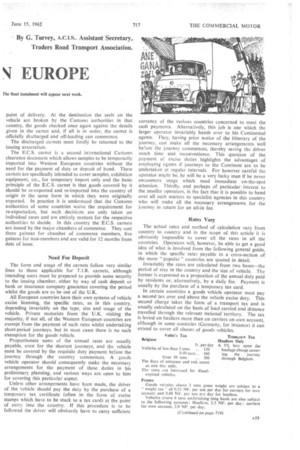GOODS VEHICLE OPERATIO EUROPE
Page 66

Page 67

If you've noticed an error in this article please click here to report it so we can fix it.
By G. Turvey, A.C.I.S.. Assistant Secretary, Traders Road Transport Association.
THIS week I want to concentrate on two major topics of vital concern to operators using, or proposing to use, their vehicles on the Continent: (a) Customs procedures, and (b) vehicle taxation for short-period journeys through Europe.
A goods vehicle operator must look at the question of Customs requirements from two points of view, covering the vehicle itself and the goods carried in that vehicle.
Both, but particularly the latter, can give rise to many problems and complexities, and it is well outside the scope of this article to cover comprehensively an the factors involved. I shalt not, for example, mention in any detail such questions as existing Customs tariffs, import and export duties, licences, etc. All these factors and many more must be taken into account by exporters and importers, and operators who have any doubts on these questions would always be well advised to contact their local office of H.M. Customs and Excise.
However, notwithstanding the complexities of individual cases, certain aspects of the requirements in this field, falling into two categories, can be covered in general terms.
In the first place a Triptyque or Carnet de Passage en Douane must be obtained. This document, obtainable from the A.A. for 30s., is valid for one year from date of issue. Its purpose is to provide Customs cover for the actual vehicle, and only the vehicle, as it travels through the various countries and, more particularly, as it crosses national frontiers.
Vehide Identification Form
In addition to this document, a Customs and Excise Motor Vehicle Identification Form should always be completed before the journey starts. This form, known as form 29C Sale, serves, as the name implies, to verify the origin and identification of the vehicle when re-importation is required. The form itself is in two parts, both of which must be completed and signed by the owner of the vehicle. The form intact is presented to the examining officer of Customs and Excise at the place of export; part two is retained by him and part one is kept by the driver for use on his return to the U.K. The forms are available from H.M. Stationery Office.
I want to restrict my remarks under this heading to two types of carnets, each of which in its own field can be of immense value to importers and exporters carrying their goods by road. The T.I.R. carnets, brought into being by the 1959 Customs Convention on the International Carriage of Goods by Road, are specifically designed to provide facilities for freer movement for goods carried by road vehicles engaged in international transport. Goods not covered by such carnets are, in the normal course of events, subject to Customs examination at every frontier post throughout the journey and, furthermore, the carrier is in many instances required to pay a bond to the Customs of the transit countries covering the goods whilst they are being carried through those countries.
B32 The possession of a T.I.R. carnet provides exemption for the carrier from all but the initial and final CustomE examinations and, in addition, he will not, unless there are any specific reasons to the contrary, be required to pay a deposit of duties and taxes at Customs offices en route.
The possession of a T.I.R. carnet can obviously save a vehicle operator much time, expense and trouble, especially when a journey involves transit through many countries.
The mechanics of the T.I.R. carnet scheme are relatively simple and for the guidance of operators a brief resunk of the various factors involved is given below.
Before a vehicle can be used under the T.I.R. scheme it must be examined by a Ministry of Transport vehicle examiner to ensure that it complies with the technical conditions laid down in the Customs Convention. Such approval may only be granted for vehicles constructed at adapted in such a manner that: Customs seals can be simply and effectively affixed to them; no goods can be removed from, or introduced into, the sealed part of the vehicle without obvious damage to it or without breaking the seals, and there are no concealed spaces where goods may be hidden.
Many more requirements must be satisfied, but none should prove to be insuperable in the case of what might be termed " normal vehicles. Nor need the vehicle be of the closed type—flat vehicles may be used provided they can be adequately sheeted.
The vehicle examination must perforce. be the first ster for operators wishing to use 'FIR. carnets. The examina, tion itself costs five guineas and the certificates of approval issued are valid for two years.
The carnets themselves, sixor 14-page booklets in which full particulars of the goods to be carried must be listed are obtainable in this country from the Traders Road Transport Association and the Road Haulage Association The six-voucher carnets, for use when only one national frontier is to be crossed, cost 20s. each; the 14-vouchei carnets, for use in all other instances, costing 25s. each. A carnet covers one journey only and is valid for a period oi two months from date of issue. Plates measuring 250 mm. x 400 mm., showing white letters " T.I.R." or a blue background, must be fitted to the front and rear ot the vehicle.
Details of Goods
Once the vehicle has been approved by the Ministry ol Transport and the necessary certificate of approval granted the carnets can be issued. Full details of the goods carried must be entered on the vouchers within the carnet—the details so given being checked against the goods by the Customs officer at the port of exit. If all is in ordel the vehicle is sealed by the officer, the carnet is stamped and the journey can commence.
From then on, unless the Customs authorities en route have any reason to decide otherwise, the vehicle should be allowed more or less uninterrupted passage through to the point of delivery. At the destination the seals on the vehicle are broken by the Customs authorities in that country, the goods checked once again against the details given in the carnet and, if all is in order, the carnet is officially discharged and off-loading can commence.
The discharged carnets must finallY be returned to the issuing association.
The E.C.S. carnet is a second international Customs clearance document which allows samples to be temporarily imported into Western European countries without the need for the payment of duty or deposit of bond. These carnets are specifically intended to cover samples, exhibition equipment, etc., for temporary import only and the basic principle of the E.C.S. carnet is that goods covered by it should be re-exported and re-imported into the country of origin in the same form in which they were originally exported. in practice it is understood that the Customs authorities of some countries waive the requirement for re-exportation, but such decisions are only taken on individual cases and are entirely matters for the respective authorilies to decide. in this country the E.C.S. carnets are issued by the major chambers of commerce. They cost three guineas for chamber of commerce members, five guineas for non-members and are valid for 12 months from date of issue.
Need For Deposit The form and usage of the carnets follow very similar lines to those applicable for T.I.R. carnets, although intending users must be prepared to provide some security to the issuing chamber, either by way of cash deposit or bank or insurance company guarantee covering the period whilst the goods are to be out of the U.K.
All European countries have their own systems of vehicle excise licensing, the specific rates, as in this country, depending invariably on the type, size and usage of the vehicle. Private motorists from the U.K. visiting the majority, if not all, of the Western European countries are exempt from the payment of such rates whilst undertaking short-period journeys, but in most cases there is no such exemption for the goods vehicle.
Proportionate sums of the annual rates are usually payable, even for the shortest journeys, and the vehicle must be covered by the requisite duty payment before the journey through the country commences. A goods vehicle operator should consequently make the necessary arrangements for the payment of these duties in his preliminary planning, and various ways are open to him for covering this particular aspect.
Unless other arrangements have been made, the driver of the vehicle should pay the duty by the purchase of a temporary tax certificate (often in the form of excise stamps which have to be stuck to a tax card) at the point of entry into the country. If this procedure is to be followed the driver will obviously have to carry sufficient
currency of the various countries concerned to meet the cash payments. Alternatively, this job is one which the larger operator invariably hands over to his Continental agents. They, having prior notice of the itinerary of the journey, can make all the necessary arrangements well before the journey commences, thereby saving the driver much time and inconvenience. This question of the payment o excise duties highlights the advantages of employing agents if journeys to the Continent are to be undertaken at regular intervals. For however careful the operator might be, he will be a very lucky man if he never encounters snags which need immediate on-the-spot attention. Thirdly, and perhaps of particular. interest to the smaller operators, is the fact that it is possible to hand over all such matters to specialist agencies in this country who will make all the necessary arrangements for the journey in return for an all-in fee.
Rates Vary The actual rates and method of calculation vary from country to country and in the scope of this article it is obviously impossible to cover all the rates in all the countries. Operators will, however, be able to get a good idea of what is involved from the following general guide, in which the specific rates payable in a cross-section of the more " popular " countries are quoted in detail.
Invariably the rates are calculated from two bases—the period of stay in the country and the size of vehicle. The former is expressed as a proportion of the annual duty paid by residents or, alternatively, by a daily fee. Payment is usually by the purchase of a temporary tax card.
In certain countries a goods vehicle operator must pay a second tax over and above the vehicle excise duty. This second charge takes the form of a transport tax and is usually calculated on the basis of load carried and distance travelled through the relevant national* territory. The tax is levied on hauliers more than on carriers on own account, although in some countries (Germany, for instance) it can extend to cover all classes of goods vehicles.
The days of entrance and exit count as one day only.
The rates are increased for dieselengined vehicles.
France Goods vehicles above 3 tons gross weight are subject to a " weight tax " of 0.55 NE. per ton per day for carriers for own account and 0.60 NF. per ton per day for hauliers.
Vehicles above 6 tons undertaking long hauls are also subject to the following surtaxes : Hauliers, 2.5 NF. per day; carriers for own account, 2.0 NF. per day.




















































































































